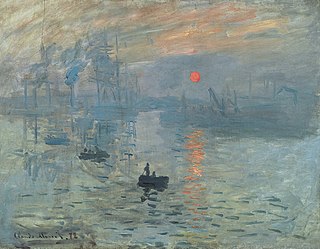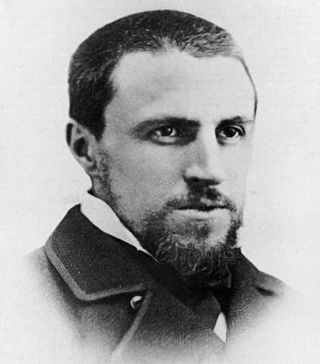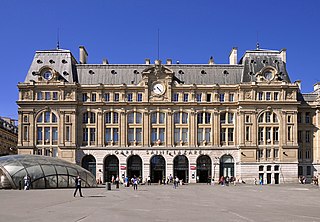
Impressionism was a 19th-century art movement characterized by relatively small, thin, yet visible brush strokes, open composition, emphasis on accurate depiction of light in its changing qualities, ordinary subject matter, unusual visual angles, and inclusion of movement as a crucial element of human perception and experience. Impressionism originated with a group of Paris-based artists whose independent exhibitions brought them to prominence during the 1870s and 1880s.

Pierre-Auguste Renoir was a French artist who was a leading painter in the development of the Impressionist style. As a celebrator of beauty and especially feminine sensuality, it has been said that "Renoir is the final representative of a tradition which runs directly from Rubens to Watteau."

Gustave Caillebotte was a French painter who was a member and patron of the Impressionists, although he painted in a more realistic manner than many others in the group. Caillebotte was known for his early interest in photography as an art form.

Alfred Sisley was an Impressionist landscape painter who was born and spent most of his life in France, but retained British citizenship. He was the most consistent of the Impressionists in his dedication to painting landscape en plein air. He deviated into figure painting only rarely and, unlike Renoir and Pissarro, he found that Impressionism fulfilled his artistic needs.

The Gare Saint-Lazare, officially Paris Saint Lazare, is one of the seven large mainline railway station terminals in Paris, France. It was the first train station built in Paris, opening in 1837. It mostly serves train services to western suburbs, as well as intercity services toward Normandy using the Paris–Le Havre railway. Saint-Lazare is the third busiest station in France, after the Gare du Nord and Gare de Lyon. It handles 290,000 passengers each day. The current station building opened in 1889 and was designed by architect Juste Lisch; the maître d'œuvre was Eugène Flachat.
Events from the year 1872 in art.

La Grenouillère is an 1869 painting by the French impressionist painter, Claude Monet.. It depicts "Flowerpot Island", also known as the Camembert, and the gangplank to La Grenouillère, a floating restaurant and boat-hire on the Seine at Croissy-sur-Seine. He was accompanied by Pierre-Auguste Renoir, who also painted the scene at the same time.

Springtime or The Reader is an 1872 painting by the French Impressionist painter Claude Monet. It depicts his first wife, Camille Doncieux, seated reading beneath a canopy of lilacs. The painting is presently held by the Walters Art Museum.

Albert Lebourg, birth name Albert-Marie Lebourg, also called Albert-Charles Lebourg and Charles Albert Lebourg, was a French Impressionist and Post-Impressionist landscape painter of the Rouen School. Member of the Société des Artistes Français, he actively worked in a luminous Impressionist style, creating more than 2,000 landscapes during his lifetime. The artist was represented by Galerie Mancini in Paris in 1896, in 1899 and 1910 by : Galerie Bernheim-Jeune, 1903 and 1906 at the Galerie Paul Rosenberg, and 1918 and 1923 at Galerie Georges Petit.

Dance at Bougival is an 1883 oil-on-canvas painting by the French artist Pierre-Auguste Renoir, currently in the collection of the Museum of Fine Arts in Boston, Massachusetts, United States. Described as "one of the museum's most beloved works", it is one of three in a collection commissioned by Paul Durand-Ruel. It depicts a scene in the French village of Bougival, about 15 km from the center of Paris, a site utilized by many Impressionists besides Renoir including Claude Monet, Alfred Sisley, and Berthe Morisot.

Skaters in the Bois de Boulogne is an oil-on-canvas landscape painting by the French artist Pierre-Auguste Renoir, created during the winter of 1868. The painting depicts a snowscape with many Parisians, young and old, spending leisure time on a frozen park lake. Due to Renoir's strong dislike of cold temperatures and snow, the piece is one of his few winter landscapes.

Lise Tréhot was a French art model who posed for artist Pierre-Auguste Renoir from 1866 until 1872, during his early Salon period. She appeared in more than twenty paintings, including notable works such as Lise with a Parasol (1867) and In Summer (1868), and she was the model for almost all of Renoir's work featuring female figures at this time. Tréhot married Georges Brière de l'Isle in 1883 and raised four children to whom she bequeathed two of Renoir's paintings, Lise Sewing (1867–68) and Lise in a White Shawl (1872), both of which are currently held by the Dallas Museum of Art.

La Promenade is an oil on canvas, early Impressionist painting by the French artist Pierre-Auguste Renoir, created in 1870. The work depicts a young couple on an excursion outside of the city, walking on a path through a woodland. Influenced by the Rococo Revival style during the Second Empire, Renoir's La Promenade reflects the older style and themes of eighteenth-century artists like Jean-Honoré Fragonard and Jean-Antoine Watteau. The work also shows the influence of Claude Monet on Renoir's new approach to painting.

Lise with a Parasol is an oil on canvas painting by French artist Pierre-Auguste Renoir, created in 1867 during his early Salon period. The full-length painting depicts model Lise Tréhot posing in a forest. She wears a white muslin dress and holds a black lace parasol to shade her from the sunlight, which filters down through the leaves, contrasting her face in the shadow and her body in the light, highlighting her dress rather than her face. After having several paintings rejected by the Salon, Renoir's Lise with a Parasol was finally accepted and exhibited in May 1868.

Marguerite Charpentier was a French salonist and art collector who was one of the earliest champions of the Impressionists, especially Pierre-Auguste Renoir.

Bazille's Studio is an oil-on-canvas painting created in 1870 by the French Impressionist Frédéric Bazille. The painting is also known as L'Atelier de la rue Condamine, The Studio, and The Studio on the Rue La Condamine. It has been in the collection of the Musée d'Orsay in Paris since 1986. It shows the artist himself surrounded by his friends and paintings in his studio, capturing the artistic and social conditions of Paris in 1870.

Victor Chocquet was a French art collector and an ardent propagandist of Impressionism. As a senior editor at the Directorate-General of Customs and Indirect Taxes, he was present at all the exhibitions where he defended painters confronted with mockery and insults. His collection was huge. It was dispersed after his death in 1899. Many of the paintings are currently in American museums.

Diana is a painting from 1867 by the French painter Pierre-Auguste Renoir. It is thought to depict the painter's lover Lise Tréhot as the Roman goddess Diana, although the exact identification of the model in the painting is disputed by art historians.

The Batignolles group was a group of young avant-garde painters from the end of the 19th century who gathered around Édouard Manet. The group bears its name in reference to the Batignolles district, where the artists used to meet between 1869 and 1875. Many of the artists in the group later became known for the Impressionism movement.


















